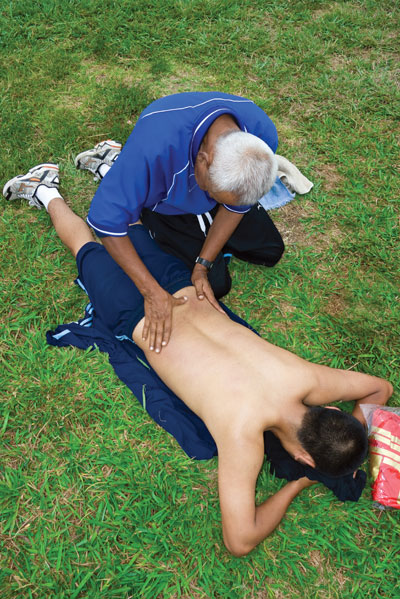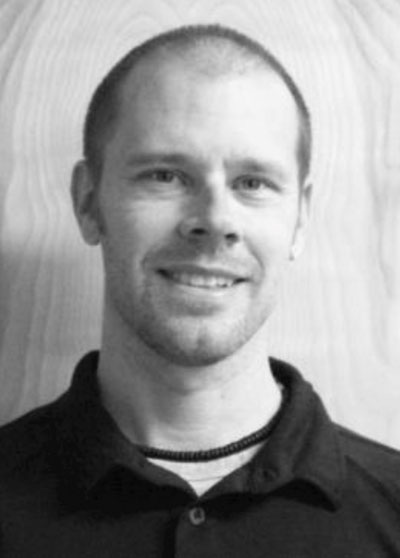
Features
Practice
Technique
Sport Massage
The discipline of sport massage was originally developed with the intent to provide specific therapy geared towards athletes who required aid in preparing their bodies for big events, recovery from those events and generalized prevention and treatment of injuries. The modern idea of sport-specific massage came about in Europe around 1900 and was first notably used at the 1924 Paris Olympics.1
September 27, 2012 By Chris Semenuk RMT
 |
|
| When performing intra-event massage, it is crucial for an RMT to be able to quickly assess their athlete, especially when injured, and relay back whether they can continue or not.
|
This description no longer appears to be strictly adhered to when many RMTs describe what they consider to be “sport massage.” This corruption of the concept has allowed the term “sport massage” to be applied to any situation, including the sedentary armchair athlete. One common misuse of the term occurs when a professional is trying to make a massage sound more masculine. The idea is that calling anything “sport” makes it more appealing. (For example, sport manicure.) However, it is still a misnomer and is being increasingly applied improperly, thus misleading the public regarding what it is – and is not – and its potential benefits when applied in the correct context. As medical professionals, it is our duty to advertise what is real and not get caught up in advertising ploys.
Although it is true that one does not need to be an Olympic-level athlete to benefit from sport massage, you, the therapist, need to have the right training and direction behind your therapy to be giving true sport-oriented massage. More specifically, you should be registered with the Canadian Sport Massage Therapists Association, or CSMTA, to call yourself a sport massage therapist. That direction comes down to “intent.” When a massage therapist (MT) administers sport massage it should be for someone who truly is athletic (maintenance) or someone who obtains an injury from a sporting activity (injury care).
Sport massage can be broken down into four main groupings: pre-event, post-event, intra-event, and inter-event.
Pre-Event Sport Massage
Pre-event massage stimulates circulation, calms nervous tension, and prepares the athlete for optimal performance while reducing the chances of injury.2 This type of massage is applied for a short period of time, relative to the body part(s) that will be utilized most intensively during the event, and is usually applied 15-45 minutes prior to an event. Therefore a pre-event massage is one performed by an MT whilst attending that event with your patient. It is also very specific in nature; it is meant to prepare your athlete for what is required and is based on that athlete’s health history.
Post-Event Sport Massage
Post-event massage helps in recovery from hard training and competition.2 This massage is best administered following an event once the athlete has cooled down and, preferably, is no longer actively sweating. However, it can be administered within hours following the event. The main goals are to reduce the effects of the event such as pain, inflammation and muscle tension.
These effects were recently solidified through a research study at McMaster University. The study methods involved performing a double-blinded muscle biopsy test following a 10-minute massage and proved that muscle tissue in a massaged muscle, when compared to a non-massaged muscle, shows similar effects to exposing the tissue to analgesic medication.3
Intra-Event Sport Massage
When massage is required by an athlete during an event break or directly between two components of an event that are close together – for example, in a soccer tournament or at track-and-field events – it is called intra-event. The goals of this type of massage combine a need to recover from activity with prepping for the next activity; as such it will be a marriage of pre- and post-event techniques as well as “on the fly” injury treatment.
When performing intra-event massage, it is crucial for an RMT to be able to quickly assess their athlete, especially when injured, and relay back whether they can continue or not. This can be more nerve-wracking for the RMT, the athlete, the medical staff and the coaching staff, as excitement may be high from the pseudo-chaos that forms while adrenalin is raised and the hastened need to know an athlete’s health status. Be aware and be confident in what your role may be in these situations!
A factor in providing intra-event massage is that you may need to get crafty with your delivery of service. You may be able to have a table with you. But you may also be required to get down to the ground to provide instantaneous care, such as in the case of an acute spasm preventing an athlete from walking or standing. A yoga mat comes in very handy for these situations.
Inter-Event Massage
That drawn-out time between performances is when inter-event massage is administered. Inter-event massage can also be referred to as training massage. This massage focuses on the prevention of developing chronic injuries and aids in the healing process of current ones.2
Inter-event massage is also the type of massage that most people perform when they say they do sport massage as part of their practice.
But, as much as inter-event massage sounds like what most RMTs do, and is probably why so many state they do sport massage, it is not. The reason stems from the background to these injuries and the needs of the athlete.
In school, you undoubtedly studied many conditions and how to treat them. This will allow you to effectively treat many sport-related injuries. What this does not prepare you for is the stage of recovery the athlete will require and what you need to do to prep the athlete.
Here’s what I mean by that: each sport has its own bio-mechanical attributes that athletes learn so they can to do their sport. Plus each sport has sub-types to it that athletes need to learn. A great example is hockey. All the players need to skate and move a puck around. But a goalie needs different dynamics than a forward, and vice versa.
To really be a sport massage-oriented MT, you need to understand the dynamics of the sport. You, essentially, need to immerse yourself as deeply in a sport as the athlete. Therefore, as an MT, you need to consider that maybe you will want to limit what kind of sport massage you will do. Most people will think: “I will offer massage for runners or golfers. ” I don’t blame you, as these are the biggest recreational activities that are also considered a sport; however, each has its own unique dynamics and requirements that you will need to be familiar with in order to provide the most effective massage for the athletes.
Understanding the sport is the key. If, for example, you have no idea why I would ask a hurdler which leg is their lead leg, and subsequently why that makes a difference, then how are you going to be able to move them from injury recovery to rehabilitative therapy properly?
These are the sorts of considerations that define why not every MT should be able to claim they do sport massage.
The CSMTA, what is its role?
The CSMTA exists as a way to identify those people who want to be organized under a banner and be recognized by a standard of excellence. This standard has been established by the CSMTA as above and beyond your initial RMT licence. The requirement is for a candidate to acquire 500 hours of direct care in sporting situations: 100 hours, minimum, come from contact and non-contact sport, and 100 hours, minimum, are derived from being at events. Fifty hours, maximum, can come from organizing medical/SMT participation at events. You need to work with at least three different sports. Finally, you will also need to hold a Sport First Responder certificate.2
Following the candidate phase, one will be able to take a written and practical exam. After obtaining 350 of the hours, a candidate is eligible to take the exam, but only after the 500 hours are complete can he/she take the practical exam.
Ultimately, membership is not required in the CSMTA if you want to do a variation on sport massage; however, if you ever wish to be an Olympic team SMT or even an SMT at any international event, then you will want to look into membership. This is because the CSMTA has a relationship with the Canadian Olympic Committee, and thus its stakeholders at national and provincial levels, to supply SMTs to various teams and athletes.
Be Educated
If you are an RMT who already does incorporate an offering of sport massage, or are thinking of adding it to your practice, do yourself a favour and become educated. Just as you learned in school that too much and not enough knowledge, at the same time, could be potentially harmful to a patient, so, too, can it apply here.
You must fully understand the movements an athlete incorporates and why they do them. You need to understand how, in many sports, the right and left sides of an athlete accomplish different tasks. The value of knowing when, in an athlete’s training schedule you should focus on something specific, or avoid something specific, could be a crucial tipping point.
Know your subject and your subject matter. This is what will make you a better therapist at any given time. You owe it to your patients to be the best and claim to do only those services for which you have the skill set and knowledge.
References
- www.gotosee.co.uk/therapies/Sports-Massage.htm
- www.csmta.ca
- J.D. Crane, D.I. Ogborn, C. Cupido, S. Melov, A. Hubbard, J.M. Bourgeois, M.A. Tarnopolsky, Massage Therapy Attenuates Inflammatory Signaling After Exercise-Induced Muscle Damage. Sci. Transl. Med. 4, 119ra13 (2012).
 |
|
Chris Semenuk is the Head of Massage Therapy for the University of Western Ontario Mustangs cross- country and track and field programs. He is also program designer and instructor at Fanshawe College’s massage therapy program. In addition Chris is a consultant for RMTs. Among other services he offers business advice, contract review, RHPA interpretation, drafting of response and resignation letters and strategies, and employment advice.
Print this page